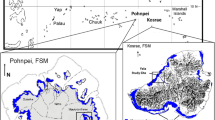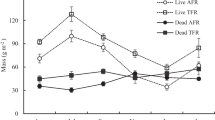Abstract
Forested wetlands are an important carbon (C) sink. Fine roots (diameter < 2 mm) dominate belowground C cycling and can be functionally defined into absorptive roots (order 1–2) and transport roots (order ≥ 3). However, effects of microtopography on the function-based fine root dynamics in forested wetlands are poorly understood. We studied fine root biomass allocation and biomass, necromass, mass loss rate, production, mortality and decomposition of absorptive and transport roots in hummocks and hollows in a coastal plain freshwater forested wetland (FFW) in the southeastern USA using dynamic-flow method. Biomass ratios of first- to second-order roots and absorptive to transport roots and the biomass and necromass of absorptive and transport roots were significantly higher in top 0–10 cm organic peat layer than in 10–20 cm muck and mineral layer, and were significantly higher in hummocks than in hollows. The mass loss rate, production, mortality and decomposition were significantly higher in hummocks than in hollows. Absorptive roots did not have a lower mass loss rate than transport roots. Microtopography significantly affected the contributions of absorptive and transport roots to the total production, mortality and decomposition. Production, mortality and decomposition of absorptive roots were higher than those of transport roots in hummocks but lower than those of transport roots in hollows. Total (hummocks plus hollows) fine root production, mortality and decomposition were 455 ± 106 g m−2 y−1, 475 ± 79 g m−2 y−1 and 392 ± 60 g m−2 y−1, respectively. Greater mortality than decomposition resulted in net fine root C input to soil. The observed microtopographic controls on fine root dynamics have great implications for soil C cycling. As sea level rises, the relative area of hollows in coastal plain FFWs will increase, causing a decrease in fine root mass loss rate, biomass, production, mortality and decomposition and it is the balance of these processes that will determine future soil C storage and cycling.




Similar content being viewed by others
References
Abramowitz M, Stegun I. 1964. Pocketbook of Mathematical Functions. Abridged edn. USA: National Bureau of Standards.
Baker TT, Conner WH, Lockaby BG, Stanturf JA, Burke MK. 2001. Fine root productivity and dynamics on a forested floodplain in South Carolina. Soil Sci Soc Am J 65:545–56.
Belyea LR, Clymo RS. 2001. Feedback control of the rate of peat formation. Proc R Soc London B 268:1315–21.
Beidler KV, Pritchard SG. 2017. Maintaining connectivity: understanding the role of root order and mycelial networks in fine root decomposition of woody plants. Plant Soil 420:19–36.
Bridgham SD, Megonigal JP, Keller JK, Bliss NB, Trettin C. 2006. The carbon balance of north American wetlands. Wetlands 26:889–916.
Clawson RG, Lockaby BG, Rummer B. 2001. Changes in production and nutrient cycling across a wetness gradient within a floodplain forest. Ecosystems 4:126–38.
Crawford ER, Day FP, Atkinson RB. 2007. Influence of environment and substrate quality on root decomposition in naturally regenerating and restored Atlantic white cedar wetlands. Wetlands 27:1–11.
Day FP, Megonigal JP. 1993. The relationship between variable hydroperiod, production allocation, and belowground organic matter turnover in forested wetlands. Wetlands 13:115–21.
Day JJ, Templet P. 1989. Consequences of sea level rise: implications from the Mississippi Delta. Coast Manage 17:241–57.
Duberstein JA, Conner WH, Krauss KW. 2014. Woody vegetation communities of tidal freshwater swamps in South Carolina, Georgia and Florida (US) with comparisons to similar systems in the US and South America. J Veg Sci 25:848–62.
Ensign SH, Noe GB. 2018. Tidal extension and sea-level rise: recommendations for a research agenda. Front Ecol Environ 16:37–43.
Fan PP, Guo DL. 2010. Slow decomposition of lower order roots: a key mechanism of root carbon and nutrient retention in the soil. Oecologia 163:509–15.
Guo D, Mitchell RJ, Withington JM, Fan PP, Hendricks JJ. 2008. Endogenous and exogenous controls of root life span, mortality and nitrogen flux in a longleaf pine forest: root branch order predominates. J Ecol 96:737–45.
Hertel D, Leuschner C. 2002. A comparison of four different fine root production estimates with ecosystem carbon balance data in a Fagus-Quercus mixed forest. Plant Soil 239:237–51.
IPCC. 2013. Climate change 2013: the physical science basis. In: Stocker D, Qin G-K, Plattner M, Tignor SK, Allen J, Boschung A, Nauels Y, Xia V Bex, Midgley PM, Eds. Contribution of Working Group I to the Fifth Assessment Report of the Intergovernmental Panel on Climate Change. Cambridge, UK: Cambridge University Press.
Iversen CM, Murphy MT, Allen MF, Childs J, Eissenstat DM, Lilleskov EA, Sarjala TM, Sloan VL, Sullivan PF. 2012. Advancing the use of minirhizotrons in wetlands. Plant Soil 352:23–39.
Jackson RB, Mooney HA, Schulze ED. 1997. A global budget for fine root biomass, surface area, and nutrient contents. Proc Natl Acad Sci USA 94:7362–6.
Jones RH, Lockaby BG, Somers GL. 1996. Effects of microtopography and disturbance on fine-root dynamics in wetland forests of low-order stream floodplains. Am Midl Nat 136:57–71.
Jones RH, Henson KO, Somers GL. 2000. Spatial, seasonal, and annual variation of fine root mass in a forested wetland. J Torrey Bot Soc 127:107–14.
Kou L, Jiang L, Fu X, Dai X, Wang H, Li S. 2018. Nitrogen deposition increases root production and turnover but slows root decomposition in Pinus elliottii plantations. New Phytol 218:1450–61.
Kou L, Guo DL, Yang H, Gao WL, Li SG. 2015. Growth, morphological traits and mycorrhizal colonization of fine roots respond differently to nitrogen addition in a slash pine plantation in subtropical China. Plant Soil 391:207–18.
Krauss KW, Noe GB, Duberstein JA, Conner WH, Stagg CL, Cormier N, Jones MC, Bernhardt CE, Lockaby BG, From AS, Doyle TW, Day RH, Ensign Pierfelice K N, Hupp CR, Chow AT, Whitbeck JL. 2018. The role of the upper tidal estuary in wetland blue carbon storage and flux. Global Biogeochem Cycles 32:817–39.
Krauss KW, Whitbeck JL, Howard RJ. 2012. On the relative roles of hydrology, salinity, temperature, and root productivity in controlling soil respiration from coastal swamps (freshwater). Plant Soil 358:265–74.
Krauss KW, Doyle TW, Twilley RR, Rivera-Monroy VH, Sullivan JK. 2006. Evaluating the relative contributions of hydroperiod and soil fertility on growth of south Florida mangroves. Hydrobiologia 569:311–24.
Li X, Lange H. 2015. A modified soil coring method for measuring fine root production, mortality and decomposition in forests. Soil Biol Biochem 91:192–9.
Makita N, Hirano Y, Mizoguchi T, Kominami Y, Dannoura M, Ishii H, Finer L, Kanazawa Y. 2010. Very fine roots respond to soil depth: biomass allocation, morphology, and physiology in a broad-leaved temperate forest. Ecol Res 26:95–104.
McCormack ML, Adams TS, Smithwick EAH, Eissenstat DM. 2014. Variability in root production, phenology, and turnover rate among 12 temperate tree species. Ecology 95:2224–35.
McCormack LM, Dickie IA, Eissenstat DM, Fahey TJ, Fernandez CW, Guo D, Helmisaari H-S, Hobbie EA, Iversen CM, Jackson RB, Leppälammi-Kujansuu J, Norby RJ, Phillips RP, Pregitzer KS, Pritchard SG, Rewald B, Zadworny M. 2015. Redefining fine roots improves understanding of belowground contributions to terrestrial biosphere processes. New Phytol 207:505–18.
McCormack LM, Guo D. 2014. Impacts of environmental factors on fine root lifespan. Front Plant Sci 5:205.
Megonigal JP, Day FP. 1992. Effects of flooding on root and shoot production of bald 5 cypress in large experimental enclosures. Ecology 73(4):1182–93.
Miao G. 2013. A multi-scale study on respiratory processes in a lower coastal plain forested wetland in the southeastern United States. Dissertation, North Carolina State University.
Miao G, Noormets A, Domec J-C, Fuentes M, Trettin CC, Sun G, McNulty SG, King JS. 2017. Hydrology and microtopography control carbon dynamics in wetlands: implications in partitioning ecosystem respiration in a coastal plain forested wetland. Agric For Meteorol 247:343–55.
Mitsch WJ, Gosselink JG. 1993. Wetlands. 2nd edn. New York: Van Nostrand Reinhold.
Mitsch WJ, Bernal B, Nahlik AM, Mander Ü, Zhang L, Anderson CJ, Jørgensen SE, Brix H. 2013. Wetlands, carbon, and climate change. Landsc Ecol 28:583–97.
Minick KJ, Kelley AM, Miao G, Li X, Noormets A, Mitra B, King JS. 2019a. Microtopography alters hydrology, phenol oxidase activity and nutrient availability in organic soils of a coastal freshwater forested wetland. Wetlands 39:263–73.
Minick JK, Mitra B, Li X, Noormets A, King J. 2019b. Water table drawdown alters soil and microbial carbon pool size and isotope composition in coastal freshwater forested wetlands. Front Glob Change . https://doi.org/10.3389/ffgc.2019.00007.
Moorhead KK, Brinson MM. 1995. Response of wetlands to rising sea level in the lower coastal plain of North Carolina. Ecol Appl 5:261–71.
Noe G, Hupp C, Rybicki N. 2013. Hydrogeomorphology influences soil nitrogen and phosphorus mineralization in floodplain wetlands. Ecosystems 16:75–94.
Norby RJ, Jackson RB. 2000. Root dynamics and global change: seeking an ecosystem perspective. New Phytol 147:3–12.
Ostertag R, Hobbie SE. 1999. Early stages of root and leaf decomposition in Hawaiian forests: effects of nutrient availability. Oecologia 121:564–73.
Persson H. 1980. Spatial distribution of fine-root growth, mortality and decomposition in a young scots pine stand in Central Sweden. Oikos 34:77–87.
Prieto I, Roumet C, Cardinael R, Dupraz C, Jourdan C, Kim JH, Maeght JL, Mao Z, Pierret A, Portillo N et al. 2015. Root functional parameters along a land-use gradient: evidence of a community-level economics spectrum. J Ecol 103:361–73.
Pierfelice K, Graeme LB, Krauss K, Conner W, Noe G, Ricker M. 2015. Salinity influences on aboveground and belowground net primary productivity in tidal wetlands. J Hydrol Eng 22:D5015002.
Poorter H, Nagel O. 2000. The role of biomass allocation in the growth response of plants to different levels of light, CO2, nutrients and water: a quantitative review. Aust J Plant Physiol 27:1191.
Powell SW, Day FP. 1991. Root production in four communities in the great dismal swamp. Am J Bot 78:288–97.
Pregitzer KS, DeForest JL, Burton AJ, Allen MF, Ruess RW, Hendrick RL. 2002. Fine root architecture of nine north American trees. Ecol Monogr 72:293–309.
Riggs SR. 1996. Sediment evolution and habitat function of organic-rich muds within the Albemarle estuarine system, North Carolina. Estuaries 19:169–85.
Rodgers HLR, Day FP, Atkinson R. 2004. Root dynamics in restored and naturally regenerated Atlantic white cedar wetlands. Restor Ecol 16:401–11.
Rotzoll K, Fletcher CH. 2013. Assessment of groundwater inundation as a consequence of sea-level rise. Nat Clim Change 3:477–81.
Sallenger AH Jr, Doran KS, Howd PA. 2012. Hotspot of accelerated sea-level rise on the Atlantic coast of North America. Nat Clim Change 2:884–8.
Schilling EB, Lockaby BG. 2005. Microsite influences on productivity and nutrient circulation within two southeastern floodplain forests. Soil Sci Soc Am J 69:1185–95.
Stagg CL, Schoolmaster DR, Krauss KW, Cormier N, Conner WH. 2017. Causal mechanisms of soil organic matter decomposition: deconstructing salinity and flooding impacts in coastal wetlands. Ecology 98:2003–18.
Symbula M, Day FP. 1988. Evaluation of two methods for estimating belowground production in a freshwater swamp forest. Am Midl Nat 120:405–15.
Sun JJ, Gu JC, Wang ZQ. 2012. Discrepancy in fine root turnover estimates between diameter-based and branch-order-based approaches: a case study in two temperate tree species. J For Res 23:575–81.
Xiong YM, Fan PP, Fu SL, Zeng H, Guo DL. 2013. Slow decomposition and limited nitrogen release by lower order roots in eight Chinese temperate and subtropical trees. Plant Soil 363:19–31.
Acknowledgement
Primary support was provided by USDA NIFA (Multi-agency A.5 Carbon Cycle Science Program) award 2014-67003-22068. Additional support was provided by DOE NICCR award 08-SC-NICCR-1072, the USDA Forest Service Eastern Forest Environmental Threat Assessment Center award 13-JV-11330110-081, and Carolinas Integrated Sciences and Assessments award 2013-0190/13-2322. The USFWS Alligator River National Wildlife Refuge provided helpful scientific discussions, the forested wetland research sites, and valuable in-kind support.
Author information
Authors and Affiliations
Corresponding author
Additional information
Author’s Contribution
X.L. and J. K. conceived the ideas and designed the research, X.L. analyzed the data; X.L., J.L. and K.M. collected the data; X.L., S.N., K.M., A.N., G.M., B.M., J.C., G.S. and J.K. led the writing of the manuscript.
Electronic supplementary material
Below is the link to the electronic supplementary material.
Rights and permissions
About this article
Cite this article
Li, X., Minick, K.J., Luff, J. et al. Effects of Microtopography on Absorptive and Transport Fine Root Biomass, Necromass, Production, Mortality and Decomposition in a Coastal Freshwater Forested Wetland, Southeastern USA. Ecosystems 23, 1294–1308 (2020). https://doi.org/10.1007/s10021-019-00470-x
Received:
Accepted:
Published:
Issue Date:
DOI: https://doi.org/10.1007/s10021-019-00470-x




